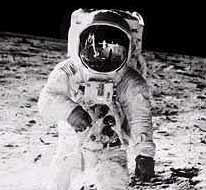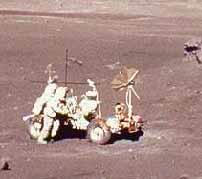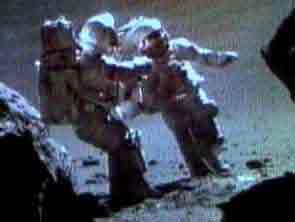|
> History > Human in Moon > Recent & Future Developments
|
In 1969, humankind achieved the long-sought goal of landing on the Moon. The historic flight of Apollo 11 was launched on July 16. After entering lunar orbit, Colonel Edwin E. Aldrin, Jr., of the air force and Neil A. Armstrong transferred to the LM. Armstrong, a civilian, was a naval veteran. Lieutenant Colonel Michael Collins of the air force remained in lunar orbit following the separation, piloting the command and service module. The LM descended to the surface of the Moon on July 20, landing at the edge of Mare Tranquillitatis. A few hours later, Armstrong, in his bulky space suit, descended the ladder and, at 10:56 pm (Eastern Daylight Time) stepped on to the surface of the Moon. His first words were, “That’s one small step for [a] man, one giant leap for mankind”. He was soon joined by Aldrin, and the two astronauts spent more than two hours walking on the lunar surface. They gathered 21 kg (47 lb) of soil samples, took photographs, and set up a solar wind experiment, a laser-beam reflector, and a seismic experiment package. Armstrong and Aldrin also erected an American flag and talked, by satellite communications, with President Richard M. Nixon in the White House. They found that walking and running in one-sixth the gravity of Earth was not difficult. Also via satellite, millions of people watched live television broadcasts from the Moon. Returning to the LM and discarding their space suits, the two astronauts rested for several hours before take-off. They left the Moon in the ascent stage of the LM, using the lower half, which remained on the Moon, as a launchpad. The ascent stage was jettisoned after docking with the command and service module and the transfer of the astronauts to the spacecraft. The return flight of Apollo 11 was without mishap and the vehicle splashed down on July 24 in the Pacific Ocean near Hawaii and was recovered.
Because of the slight possibility of terrestrial contamination by living lunar organisms, the astronauts put on biological isolation garments before leaving the spacecraft and were placed in quarantine for three weeks. They remained in good health. Apollo 12The next moon-landing flight began on November 14, 1969, when Apollo 12
was launched with astronauts Pete Conrad, Richard F. Gordon, Jr., and Alan
L. Bean, all of the navy, aboard. After entering lunar orbit, command
pilot Conrad and Bean, the pilot of the LM, transferred to the LM. They
landed north of the Riphaeus Mountains, at a spot just 180 m (600 ft) from
where the Surveyor 3 spacecraft had landed two years before. [Top] Apollo 13On April 11, 1970, Apollo 13 was launched, carrying the veteran astronaut Lovell and the civilian astronauts Fred W. Haise, Jr., and John L. Swigert, Jr. The craft met with disaster during the flight when an oxygen tank ruptured. The astronauts were obliged to cancel their planned landing on the lunar surface. Instead, using the power and survival systems of the LM, they swung behind the Moon and were then brought back to Earth for a splashdown south of Pago Pago in the South Pacific Ocean on April 17. [Top] Apollo 14 & 15The mission of the aborted Apollo 13 was accomplished by
the crew of Apollo 14, launched on January 31, 1971, after modifications
were carried out in the spacecraft to prevent a recurrence of the
malfunctions encountered by Apollo 13. Captain Shepard, who had been
promoted after his successful sub-orbital flight in 1961, and Commander Edgar D. Mitchell, also of the
navy, successfully landed the LM in the rugged Fra Mauro region of the
Moon, while astronaut Stuart A. Roosa of the air force remained in lunar
orbit in the CM. Shepard and Mitchell spent more than 9 hours exploring an
area believed to contain some of the oldest rocks yet recovered,
collecting about 43 kg (96 lb) of geological samples and deploying
scientific instruments. The astronauts returned to Earth without incident
on February 9, 1971. [Top] Apollo 16 & 17
On April 16, 1972, astronauts Young, Charles Moss Duke, Jr., and Thomas Kenneth (Ken) Mattingly were launched on the Apollo 16 mission to the Moon, to explore the Descartes Highlands and the Cayley Plains regions. While Mattingly remained in orbit, the other two astronauts landed in the assigned area on April 20. They spent 20 hours, 14 minutes on the Moon, setting up a number of experiments powered by a small nuclear station, travelling about 26.6 km (16.5 mi) in the lunar rover, and collecting more than 97 kg (214 lb) of rock samples.
The projected missions to the Moon by the United States
were concluded with the flight of Apollo 17, December 6-19, 1972. During
their smooth 13-day voyage, the veteran astronaut Cernan and the American
civilian geologist Harrison H. Schmitt spent 22 hours on the Moon,
travelling 35 km (22 mi) in their lunar rover and exploring the Taurus-Littrow
Valley region, while Commander Ronald E. Evans of the navy remained in
lunar orbit.
|


